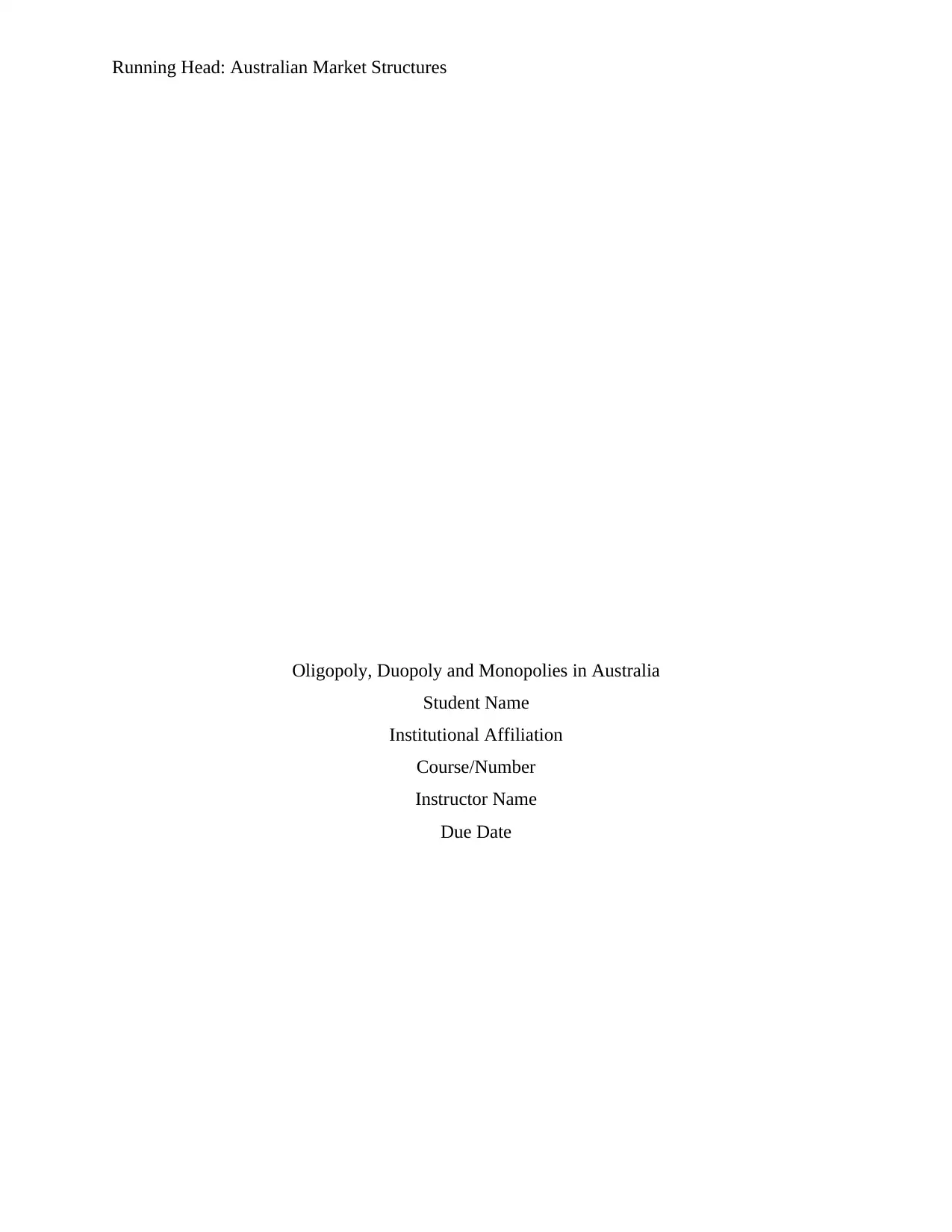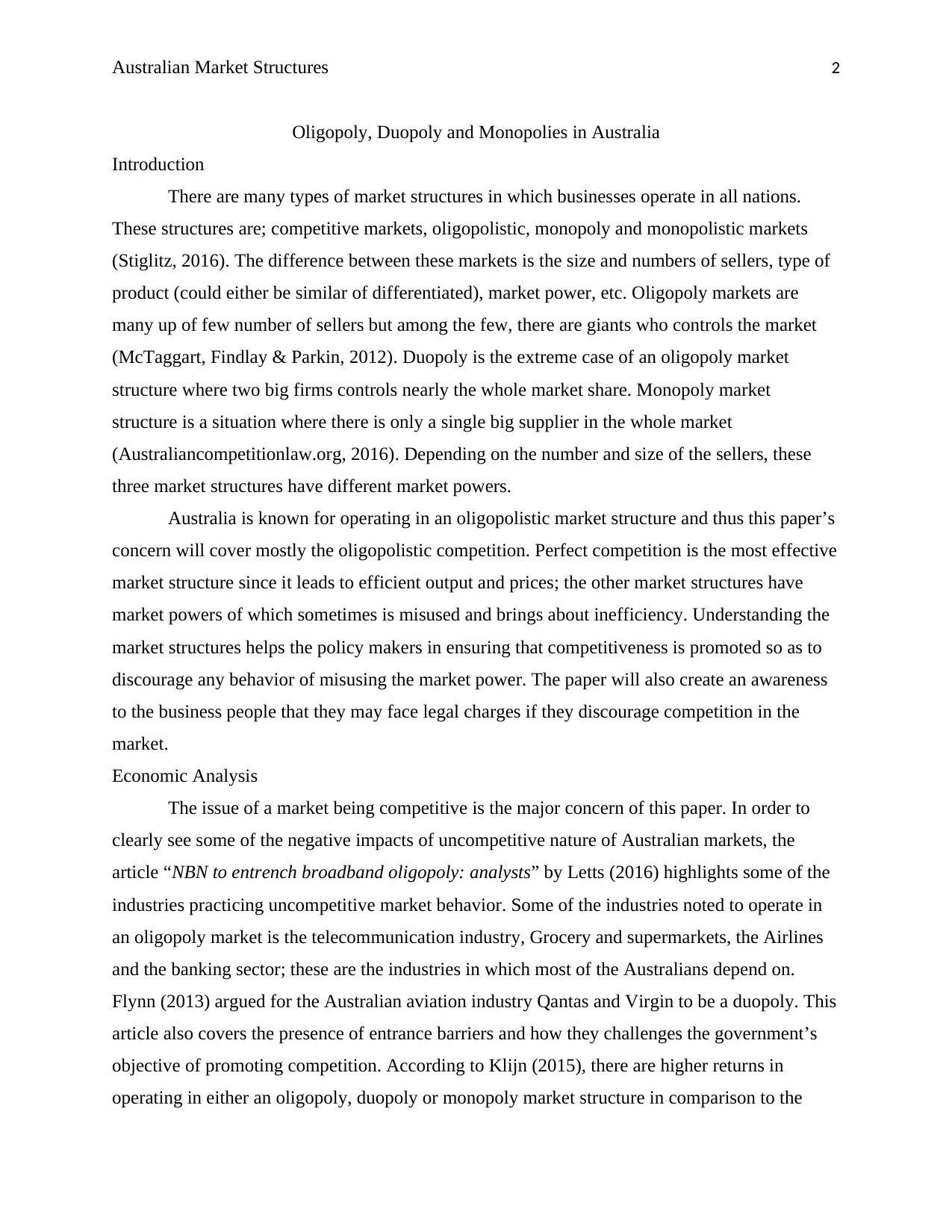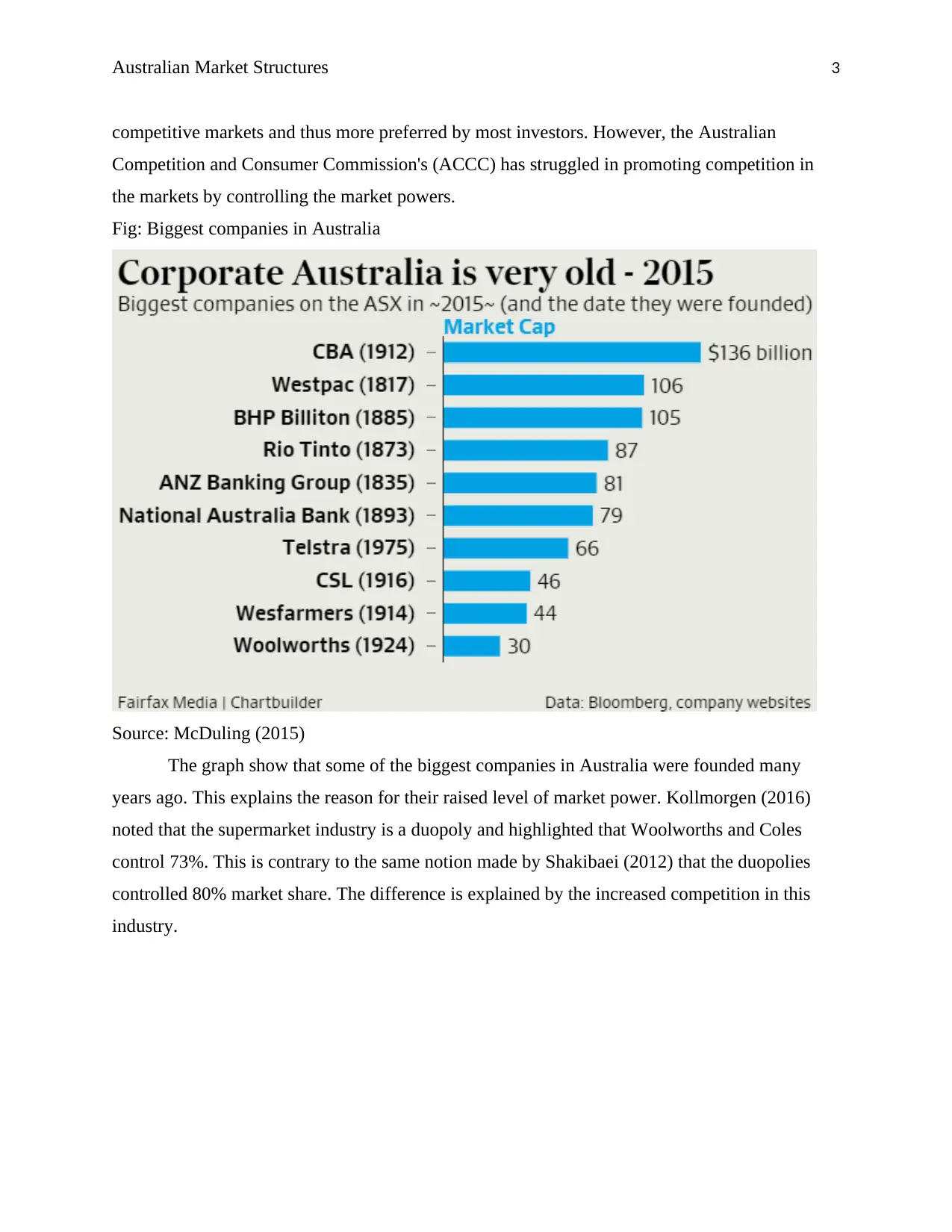Market Structures: Oligopoly, Duopoly, and Monopolies in Australia
VerifiedAdded on 2020/02/24
|6
|1441
|54
Report
AI Summary
This report analyzes the various market structures prevalent in Australia, focusing on oligopolies, duopolies, and monopolies. It provides an introduction to these market types, highlighting their differences in terms of the number of sellers, product differentiation, and market power. The report then delves into an economic analysis of the Australian market, noting the prevalence of oligopolistic behavior in key sectors such as telecommunications, groceries, airlines, and banking. It discusses the role of the Australian Competition and Consumer Commission (ACCC) in promoting competition and mitigating the negative impacts of concentrated market power. The report also examines the presence of barriers to entry and their impact on competition, citing examples like the duopoly of Woolworths and Coles in the supermarket industry and the shift from a quasi-monopoly to an oligopoly in the telecommunications sector. The report concludes with a recommendation for policies that foster increased competition, such as eliminating barriers to entry and ensuring a low-cost business environment, to improve living standards and promote more affordable products and services. The report emphasizes the importance of government regulation in ensuring competitive markets and preventing the misuse of market power by businesses, ultimately influencing price levels and output efficiency.

Running Head: Australian Market Structures
Oligopoly, Duopoly and Monopolies in Australia
Student Name
Institutional Affiliation
Course/Number
Instructor Name
Due Date
Oligopoly, Duopoly and Monopolies in Australia
Student Name
Institutional Affiliation
Course/Number
Instructor Name
Due Date
Paraphrase This Document
Need a fresh take? Get an instant paraphrase of this document with our AI Paraphraser

Australian Market Structures 2
Oligopoly, Duopoly and Monopolies in Australia
Introduction
There are many types of market structures in which businesses operate in all nations.
These structures are; competitive markets, oligopolistic, monopoly and monopolistic markets
(Stiglitz, 2016). The difference between these markets is the size and numbers of sellers, type of
product (could either be similar of differentiated), market power, etc. Oligopoly markets are
many up of few number of sellers but among the few, there are giants who controls the market
(McTaggart, Findlay & Parkin, 2012). Duopoly is the extreme case of an oligopoly market
structure where two big firms controls nearly the whole market share. Monopoly market
structure is a situation where there is only a single big supplier in the whole market
(Australiancompetitionlaw.org, 2016). Depending on the number and size of the sellers, these
three market structures have different market powers.
Australia is known for operating in an oligopolistic market structure and thus this paper’s
concern will cover mostly the oligopolistic competition. Perfect competition is the most effective
market structure since it leads to efficient output and prices; the other market structures have
market powers of which sometimes is misused and brings about inefficiency. Understanding the
market structures helps the policy makers in ensuring that competitiveness is promoted so as to
discourage any behavior of misusing the market power. The paper will also create an awareness
to the business people that they may face legal charges if they discourage competition in the
market.
Economic Analysis
The issue of a market being competitive is the major concern of this paper. In order to
clearly see some of the negative impacts of uncompetitive nature of Australian markets, the
article “NBN to entrench broadband oligopoly: analysts” by Letts (2016) highlights some of the
industries practicing uncompetitive market behavior. Some of the industries noted to operate in
an oligopoly market is the telecommunication industry, Grocery and supermarkets, the Airlines
and the banking sector; these are the industries in which most of the Australians depend on.
Flynn (2013) argued for the Australian aviation industry Qantas and Virgin to be a duopoly. This
article also covers the presence of entrance barriers and how they challenges the government’s
objective of promoting competition. According to Klijn (2015), there are higher returns in
operating in either an oligopoly, duopoly or monopoly market structure in comparison to the
Oligopoly, Duopoly and Monopolies in Australia
Introduction
There are many types of market structures in which businesses operate in all nations.
These structures are; competitive markets, oligopolistic, monopoly and monopolistic markets
(Stiglitz, 2016). The difference between these markets is the size and numbers of sellers, type of
product (could either be similar of differentiated), market power, etc. Oligopoly markets are
many up of few number of sellers but among the few, there are giants who controls the market
(McTaggart, Findlay & Parkin, 2012). Duopoly is the extreme case of an oligopoly market
structure where two big firms controls nearly the whole market share. Monopoly market
structure is a situation where there is only a single big supplier in the whole market
(Australiancompetitionlaw.org, 2016). Depending on the number and size of the sellers, these
three market structures have different market powers.
Australia is known for operating in an oligopolistic market structure and thus this paper’s
concern will cover mostly the oligopolistic competition. Perfect competition is the most effective
market structure since it leads to efficient output and prices; the other market structures have
market powers of which sometimes is misused and brings about inefficiency. Understanding the
market structures helps the policy makers in ensuring that competitiveness is promoted so as to
discourage any behavior of misusing the market power. The paper will also create an awareness
to the business people that they may face legal charges if they discourage competition in the
market.
Economic Analysis
The issue of a market being competitive is the major concern of this paper. In order to
clearly see some of the negative impacts of uncompetitive nature of Australian markets, the
article “NBN to entrench broadband oligopoly: analysts” by Letts (2016) highlights some of the
industries practicing uncompetitive market behavior. Some of the industries noted to operate in
an oligopoly market is the telecommunication industry, Grocery and supermarkets, the Airlines
and the banking sector; these are the industries in which most of the Australians depend on.
Flynn (2013) argued for the Australian aviation industry Qantas and Virgin to be a duopoly. This
article also covers the presence of entrance barriers and how they challenges the government’s
objective of promoting competition. According to Klijn (2015), there are higher returns in
operating in either an oligopoly, duopoly or monopoly market structure in comparison to the

Australian Market Structures 3
competitive markets and thus more preferred by most investors. However, the Australian
Competition and Consumer Commission's (ACCC) has struggled in promoting competition in
the markets by controlling the market powers.
Fig: Biggest companies in Australia
Source: McDuling (2015)
The graph show that some of the biggest companies in Australia were founded many
years ago. This explains the reason for their raised level of market power. Kollmorgen (2016)
noted that the supermarket industry is a duopoly and highlighted that Woolworths and Coles
control 73%. This is contrary to the same notion made by Shakibaei (2012) that the duopolies
controlled 80% market share. The difference is explained by the increased competition in this
industry.
competitive markets and thus more preferred by most investors. However, the Australian
Competition and Consumer Commission's (ACCC) has struggled in promoting competition in
the markets by controlling the market powers.
Fig: Biggest companies in Australia
Source: McDuling (2015)
The graph show that some of the biggest companies in Australia were founded many
years ago. This explains the reason for their raised level of market power. Kollmorgen (2016)
noted that the supermarket industry is a duopoly and highlighted that Woolworths and Coles
control 73%. This is contrary to the same notion made by Shakibaei (2012) that the duopolies
controlled 80% market share. The difference is explained by the increased competition in this
industry.
⊘ This is a preview!⊘
Do you want full access?
Subscribe today to unlock all pages.

Trusted by 1+ million students worldwide

Australian Market Structures 4
Fig: Economies of Scale for Oligopolies and monopolies
Cost ($)
Ac1
Ac2 LRAC
Q1 Q2 Quantity
The presence of economies of scale enables the big players to slash their prices since they
can produce more at a lower cost: the average costs falls as output rises. Since the entrants do not
have the economies of scale, they are discouraged from operating in the market. The ACCC is
succeeding in this goal as it can be noted that new investors have entered most of these market
structures and are gaining some market share whereas the market share of the big businesses is
declining. The ACCC has promoted the shift of businesses from one market structure to another
as the number of suppliers rises. Telstra a quasi-monopoly in the telco market has shifted to an
oligopoly market structures as Vocus, TPG and Optus have gained some of its initial market
share. Telstra initially controlled 80% of the industry’s revenue whereas the others controlled the
remaining 20%; thanks to the ACCC that by 2016, this company controlled 60% increasing the
control for the other firms by 20%. This has raised the profitability of other telecommunication
firms and its making an attraction to other potential investors. Letts article concluded that
competition is better than operation of firms with increased market power. It noted that the shift
of Telstra to an oligopoly is much better than when it operated as a quasi-monopoly.
Recommendation
Living standard is completely undermined by the existence of oligopoly, duopoly and
monopoly market structures in Australia. Living standards could only be promoted by ensuring
Fig: Economies of Scale for Oligopolies and monopolies
Cost ($)
Ac1
Ac2 LRAC
Q1 Q2 Quantity
The presence of economies of scale enables the big players to slash their prices since they
can produce more at a lower cost: the average costs falls as output rises. Since the entrants do not
have the economies of scale, they are discouraged from operating in the market. The ACCC is
succeeding in this goal as it can be noted that new investors have entered most of these market
structures and are gaining some market share whereas the market share of the big businesses is
declining. The ACCC has promoted the shift of businesses from one market structure to another
as the number of suppliers rises. Telstra a quasi-monopoly in the telco market has shifted to an
oligopoly market structures as Vocus, TPG and Optus have gained some of its initial market
share. Telstra initially controlled 80% of the industry’s revenue whereas the others controlled the
remaining 20%; thanks to the ACCC that by 2016, this company controlled 60% increasing the
control for the other firms by 20%. This has raised the profitability of other telecommunication
firms and its making an attraction to other potential investors. Letts article concluded that
competition is better than operation of firms with increased market power. It noted that the shift
of Telstra to an oligopoly is much better than when it operated as a quasi-monopoly.
Recommendation
Living standard is completely undermined by the existence of oligopoly, duopoly and
monopoly market structures in Australia. Living standards could only be promoted by ensuring
Paraphrase This Document
Need a fresh take? Get an instant paraphrase of this document with our AI Paraphraser

Australian Market Structures 5
that there is increased competition in the market as this would make the products and services
more affordable. This is achievable only by ensuring that barriers to entry that pre-existed and
those created by the market players are eliminated. One barrier to entry is created by slashing of
prices so as to make it less profitable for new entrants. This can be only eliminated by the
government fixing the minimum price for the goods and services. This would ensure that even at
the lowest price (minimum price), new entrant will make some profits. Australian is an economy
whose cost of doing business is very high and this is already a self-barrier to entry. This can be
eliminated by the government easing its regulations on business investments and promoting a
low-cost business environment.
Conclusion
Ensuring that firms are competitive in nature is an important government’s role. Price
levels are generally influenced by the market supply and demand for goods and services. In
competitive firms, the level of output is high and the price charged is generally low. This is
because the players in this market have no influence on price for goods and services. On the
other hand, the oligopolies, duopolies and monopolies are inefficient as the level of output is
lower. These market structures have significant influence on price as they limit the level of their
output to sell at higher prices. Without proper regulation by the government, most businesses
could choose to operate in these markets to maximize their wealth. They are able to maintain
their market power since there exist barriers to entry and the fact that they also create others of
their own.
that there is increased competition in the market as this would make the products and services
more affordable. This is achievable only by ensuring that barriers to entry that pre-existed and
those created by the market players are eliminated. One barrier to entry is created by slashing of
prices so as to make it less profitable for new entrants. This can be only eliminated by the
government fixing the minimum price for the goods and services. This would ensure that even at
the lowest price (minimum price), new entrant will make some profits. Australian is an economy
whose cost of doing business is very high and this is already a self-barrier to entry. This can be
eliminated by the government easing its regulations on business investments and promoting a
low-cost business environment.
Conclusion
Ensuring that firms are competitive in nature is an important government’s role. Price
levels are generally influenced by the market supply and demand for goods and services. In
competitive firms, the level of output is high and the price charged is generally low. This is
because the players in this market have no influence on price for goods and services. On the
other hand, the oligopolies, duopolies and monopolies are inefficient as the level of output is
lower. These market structures have significant influence on price as they limit the level of their
output to sell at higher prices. Without proper regulation by the government, most businesses
could choose to operate in these markets to maximize their wealth. They are able to maintain
their market power since there exist barriers to entry and the fact that they also create others of
their own.

Australian Market Structures 6
References
Australiancompetitionlaw.org. (2016). Competition Law Economics | Overview.
Australiancompetitionlaw.org. Retrieved 24 August 2017, from
http://www.australiancompetitionlaw.org/law/economics/index.html.
Flynn, D. (2013). Borghetti defends the Qantas-Virgin duopoly. Australian Business Traveller.
Retrieved 24 August 2017, from https://www.ausbt.com.au/borghetti-defends-the-qantas-
virgin-duopoly.
Klijn, W. (2015). Study finds Australian oligopoly premium. Theinstoreport.com.au. Retrieved
24 August 2017, from http://www.theinstoreport.com.au/articles/study-finds-australian-
oligopoly-premium.
Kollmorgen, A. (2016). Market monopolies in Australia: Is Australian suffering from a market
concentration crisis? Choice. Retrieved 24 August 2017, from
https://www.choice.com.au/shopping/everyday-shopping/supermarkets/articles/market-
concentration
Letts, 2. (2016). NBN likely to entrench broadband oligopoly: analysts. ABC News. Retrieved 24
August 2017, from http://www.abc.net.au/news/2016-04-08/nbn-to-entrench-broadband-
oligopoly/7310228.
McDuling, J. (2015). Corporate Australia's real problem: ancient companies. The Sydney
Morning Herald. Retrieved 24 August 2017, from http://www.smh.com.au/business/the-
economy/corporate-australias-real-problem-ancient-companies-20151125-gl7wu2.html.
McTaggart, D., Findlay, C. & Parkin, M. (2012). Macroeconomics. AU. Pearson Higher
Education.
Shakibaei, B. (2012). Duopolies: Woolworths and Coles. Wordpress. Retrieved 24 August 2017,
from https://markets6605.wordpress.com/2012/06/13/duopolies-woolworths-and-coles/.
Stiglitz, J. (2016). The new era of monopoly is here. The Guardian. Retrieved 24 August 2017,
from https://www.theguardian.com/business/2016/may/13/-new-era-monopoly-joseph-
stiglitz.
References
Australiancompetitionlaw.org. (2016). Competition Law Economics | Overview.
Australiancompetitionlaw.org. Retrieved 24 August 2017, from
http://www.australiancompetitionlaw.org/law/economics/index.html.
Flynn, D. (2013). Borghetti defends the Qantas-Virgin duopoly. Australian Business Traveller.
Retrieved 24 August 2017, from https://www.ausbt.com.au/borghetti-defends-the-qantas-
virgin-duopoly.
Klijn, W. (2015). Study finds Australian oligopoly premium. Theinstoreport.com.au. Retrieved
24 August 2017, from http://www.theinstoreport.com.au/articles/study-finds-australian-
oligopoly-premium.
Kollmorgen, A. (2016). Market monopolies in Australia: Is Australian suffering from a market
concentration crisis? Choice. Retrieved 24 August 2017, from
https://www.choice.com.au/shopping/everyday-shopping/supermarkets/articles/market-
concentration
Letts, 2. (2016). NBN likely to entrench broadband oligopoly: analysts. ABC News. Retrieved 24
August 2017, from http://www.abc.net.au/news/2016-04-08/nbn-to-entrench-broadband-
oligopoly/7310228.
McDuling, J. (2015). Corporate Australia's real problem: ancient companies. The Sydney
Morning Herald. Retrieved 24 August 2017, from http://www.smh.com.au/business/the-
economy/corporate-australias-real-problem-ancient-companies-20151125-gl7wu2.html.
McTaggart, D., Findlay, C. & Parkin, M. (2012). Macroeconomics. AU. Pearson Higher
Education.
Shakibaei, B. (2012). Duopolies: Woolworths and Coles. Wordpress. Retrieved 24 August 2017,
from https://markets6605.wordpress.com/2012/06/13/duopolies-woolworths-and-coles/.
Stiglitz, J. (2016). The new era of monopoly is here. The Guardian. Retrieved 24 August 2017,
from https://www.theguardian.com/business/2016/may/13/-new-era-monopoly-joseph-
stiglitz.
⊘ This is a preview!⊘
Do you want full access?
Subscribe today to unlock all pages.

Trusted by 1+ million students worldwide
1 out of 6
Related Documents
Your All-in-One AI-Powered Toolkit for Academic Success.
+13062052269
info@desklib.com
Available 24*7 on WhatsApp / Email
![[object Object]](/_next/static/media/star-bottom.7253800d.svg)
Unlock your academic potential
Copyright © 2020–2025 A2Z Services. All Rights Reserved. Developed and managed by ZUCOL.





